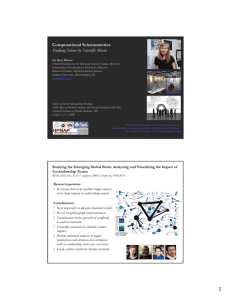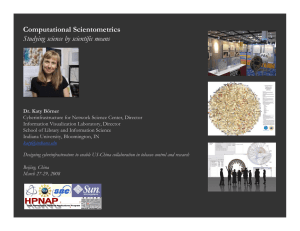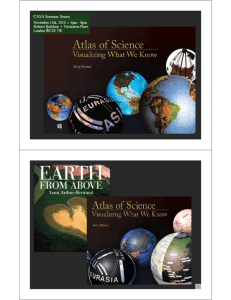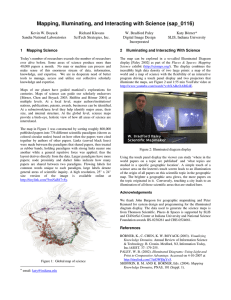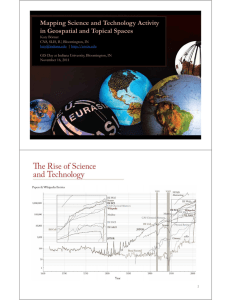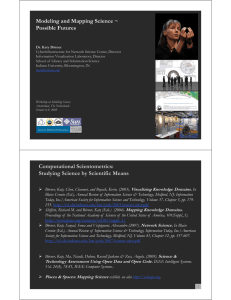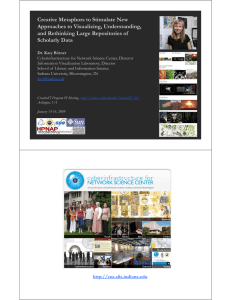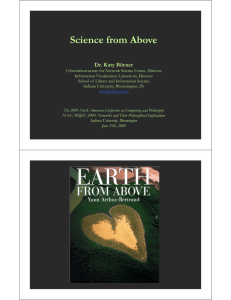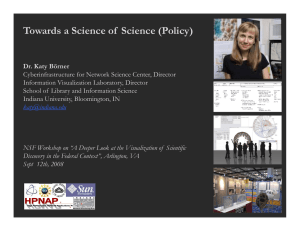Jesse M. Heines, Katy Börner, Melody Ivory, and Ed
advertisement
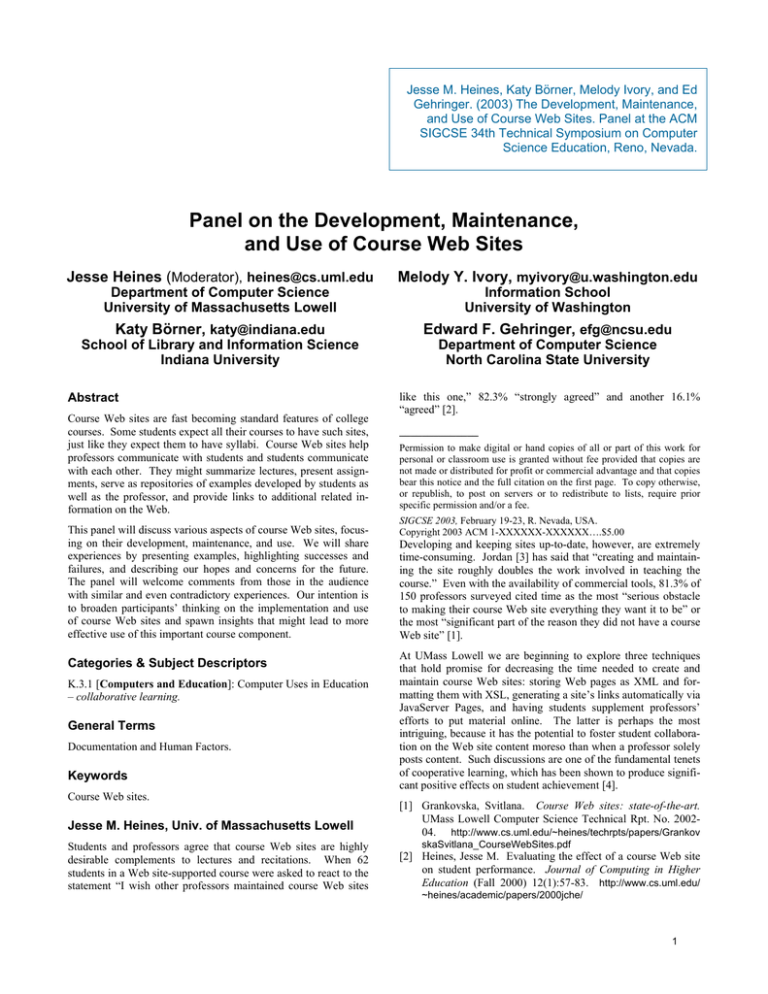
Jesse M. Heines, Katy Börner, Melody Ivory, and Ed Gehringer. (2003) The Development, Maintenance, and Use of Course Web Sites. Panel at the ACM SIGCSE 34th Technical Symposium on Computer Science Education, Reno, Nevada. Panel on the Development, Maintenance, and Use of Course Web Sites Jesse Heines (Moderator), heines@cs.uml.edu Melody Y. Ivory, myivory@u.washington.edu Department of Computer Science University of Massachusetts Lowell Information School University of Washington Katy Börner, katy@indiana.edu School of Library and Information Science Indiana University Edward F. Gehringer, efg@ncsu.edu Abstract Course Web sites are fast becoming standard features of college courses. Some students expect all their courses to have such sites, just like they expect them to have syllabi. Course Web sites help professors communicate with students and students communicate with each other. They might summarize lectures, present assignments, serve as repositories of examples developed by students as well as the professor, and provide links to additional related information on the Web. This panel will discuss various aspects of course Web sites, focusing on their development, maintenance, and use. We will share experiences by presenting examples, highlighting successes and failures, and describing our hopes and concerns for the future. The panel will welcome comments from those in the audience with similar and even contradictory experiences. Our intention is to broaden participants’ thinking on the implementation and use of course Web sites and spawn insights that might lead to more effective use of this important course component. Categories & Subject Descriptors K.3.1 [Computers and Education]: Computer Uses in Education – collaborative learning. General Terms Documentation and Human Factors. Keywords Course Web sites. Department of Computer Science North Carolina State University like this one,” 82.3% “strongly agreed” and another 16.1% “agreed” [2]. ______________ Permission to make digital or hand copies of all or part of this work for personal or classroom use is granted without fee provided that copies are not made or distributed for profit or commercial advantage and that copies bear this notice and the full citation on the first page. To copy otherwise, or republish, to post on servers or to redistribute to lists, require prior specific permission and/or a fee. SIGCSE 2003, February 19-23, R. Nevada, USA. Copyright 2003 ACM 1-XXXXXX-XXXXXX….$5.00 Developing and keeping sites up-to-date, however, are extremely time-consuming. Jordan [3] has said that “creating and maintaining the site roughly doubles the work involved in teaching the course.” Even with the availability of commercial tools, 81.3% of 150 professors surveyed cited time as the most “serious obstacle to making their course Web site everything they want it to be” or the most “significant part of the reason they did not have a course Web site” [1]. At UMass Lowell we are beginning to explore three techniques that hold promise for decreasing the time needed to create and maintain course Web sites: storing Web pages as XML and formatting them with XSL, generating a site’s links automatically via JavaServer Pages, and having students supplement professors’ efforts to put material online. The latter is perhaps the most intriguing, because it has the potential to foster student collaboration on the Web site content moreso than when a professor solely posts content. Such discussions are one of the fundamental tenets of cooperative learning, which has been shown to produce significant positive effects on student achievement [4]. Jesse M. Heines, Univ. of Massachusetts Lowell [1] Grankovska, Svitlana. Course Web sites: state-of-the-art. UMass Lowell Computer Science Technical Rpt. No. 200204. http://www.cs.uml.edu/~heines/techrpts/papers/Grankov Students and professors agree that course Web sites are highly desirable complements to lectures and recitations. When 62 students in a Web site-supported course were asked to react to the statement “I wish other professors maintained course Web sites [2] Heines, Jesse M. Evaluating the effect of a course Web site on student performance. Journal of Computing in Higher Education (Fall 2000) 12(1):57-83. http://www.cs.uml.edu/ skaSvitlana_CourseWebSites.pdf ~heines/academic/papers/2000jche/ 1 [3] Jordan, David K. Evaluation of a Web site as a teaching tool in MMW-1 (track C). Unpublished manuscript (1997). University of California, San Diego. [4] Slavin, Robert E. Research for the future: research on cooperative learning and achievement: what we know, what we need to know. Contemporary Educational Psychology (1996), 21(1):43-69. http://www.successforall.net/resource/ InformationCentered Identifying the information (syllabus, lecture notes, assignments, etc.) users need and making it available Site organized by categories of information LearnerCentered Identifying potential learners (characteristics and learning styles) and meeting their needs Site organized by types of learners research/ cooplearn.htm Katy Börner, Indiana Univ. Ideally, course Web pages provide not only information about the course (i.e., instructor’s name, meeting hours, grade composition, policies, course outline, resources, etc.), but also support handin and discussion of project results, support hands-on exploration of topics, and provide a virtual meeting and discussion space. In my teaching, I use Project Handin Web Pages [2] to support the formation and the collaboration of student teams, the automatic handin of project results, and the constructive feedback process (by students as well as by the instructor) on class projects. In addition, my Information Visualization (IV) course uses a Software Repository [1], which is intended to complement the theoretical study of specific IV algorithms and the critique and evaluation of existing applications. It facilitates the hands-on exploration, design, and customization of IVs for different user groups, of visualization tasks, and of data sets. In addition, the repository enables the comparison of different algorithms as well as the management of large class projects. In the Fall 2001 and Spring 2002 semesters, I hosted a weekly (Virtual) Reading Group on Network and Cluster Analysis [3]. Meetings were held in a lecture room as well as virtually in a 3D online space. Guests in the lecture room met with guests in the 3D space and held question/answer sessions via a chat facility. We used live audio and video streaming to ease communication. Several authors of discussed papers joined remotely. I will demonstrate these tools and share my experiences during the panel discussion. [1] Börner, Katy, and Zhou, Yuezheng. A Software Repository for Education and Research in Information Visualization. Information Visualisation Conference, London, England, July 25-27, pp. 257-262, 2001. http://ella.slis.indiana.edu/ ~katy/L697/code/ [2] Börner, Katy. L542 Human Computer Interaction Project Handin Webpage, SLIS, Indiana University, Spring 2002. http://ella.slis.indiana.edu/classes/handin/L542-S02/ [3] Börner, Katy. (Virtual) Reading Group on Network and Cluster Analysis, SLIS, Indiana University, Spring 2002. http://ella.slis.indiana.edu/~katy/ReadingGroup.html Melody Y. Ivory, Univ. of Washington The majority of Web sites have inadequate usability and accessibility, especially education sites [3]. I propose the development of a holistic design approach and the use of effective automated evaluation tools to improve the quality of course Web sites. The design approach employed during site development can lead to significantly different sites. I recently contrasted three approaches [1] (Table 1). Approach UserCentered Design Process Identifying potential users (characteristics and tasks) and meeting their needs Potential Outcome Site organized by tasks Table 1. Contrast of user-, information-, and learner-centered design processes for course Web site creation. Design considerations in Table 1 are all relevant for a course Web site, and, ideally, a site’s design reflects them all. However, it is not clear how to integrate these design approaches in creating effective course Web sites. Use of automated evaluation tools may also help educators to improve their course Web sites. For example, the WebTango Project has developed an evaluation prototype [2] that includes a statistical model for assessing education sites; this model informs educators of the predicted quality of their sites as well as how their sites are similar to or different from highly rated sites. More research needs to be conducted on the integration of such an automated evaluation tool and a holistic design process to provide more guidance and assistance to educators. [1] Ivory, Melody Y. User-centered design. WebEd Meeting, http://depts.washington.edu/webed/presenta July 8, 2002. tions.html [2] Ivory, Melody Y. and Hearst, Marti A. Improving Web Site Design. IEEE Internet Computing, Special Issue on Usability and the World Wide Web, 6(2), March/April 2002. [3] Rowland, Cyndi. Accessibility of the Internet in postsecondary education: meeting the challenge. Universal Web Accessibility Symposium, Web Net World Conference on the WWW and Internet, San Antonio, Texas, October 31, 2000. http://www.webaim.org/articles/meetchallenge Edward F. Gehringer, North Carolina State Univ. As the other panelists have indicated, the construction of an effective course Web site is necessarily a collaborative effort. Informally faculty collaborate by consulting each other’s sites when developing their own syllabi, and using tools developed by others, such as simulators. For such informal collaboration to flourish, Web sites must be free of access restrictions that prevent outsiders from viewing them. Certainly, some types of material, such as solutions to textbook problems, should not be publicly accessible. But many instructors restrict much more than solutions [1]. Some keep their work under wraps because they worry that it is not polished enough for public consumption. Others restrict because that’s the default in their courseware management system (e.g., WebCT). Finally, some universities are moving to assert ownership over faculty-developed course materials, requiring them to be licensed instead of given away. This is not widespread at the moment, but will be an increasing problem as online assessment and testing systems become more common. Student contributions, too, can be an important part of a course Web site. I use electronic peer review [3] in my own courses; students select from a list of projects (which may be research papers, reviews, lecture annotations, or compilations of hyperlinks) and submit them over the Web to be reviewed by other 2 students. The best contributions can then be compiled into resources for other students, both locally and around the world. My well known Ethics in Computing site (http://ethics.csc.ncsu.edu) was developed in this fashion [2]. We are working to improve our tools so that others will be able to use and enhance them to develop their own course Web sites. [1] Gehringer, Edward F. To see or not to see: Access restrictions on course Web sites. 2002 ASEE Annual Conference and Exposition, American Society for Engineering Education, Montreal, Quebec, Session 1520, June 16-19, 2002. [2] Gehringer, Edward F. Building an Ethics in Computing Web site using peer review. 2001 ASEE Annual Conference and Exposition, American Society for Engineering Education, Session 1461, Albuquerque, NM, June 24-27, 2001. [3] Gehringer, Edward F. Peer review and peer grading in computer-science courses. SIGCSE 2001: Thirty-Second Technical Symposium on Computer Science Education, Charlotte, NC, pp. 139–143, Feb. 21-25, 2001. 3
